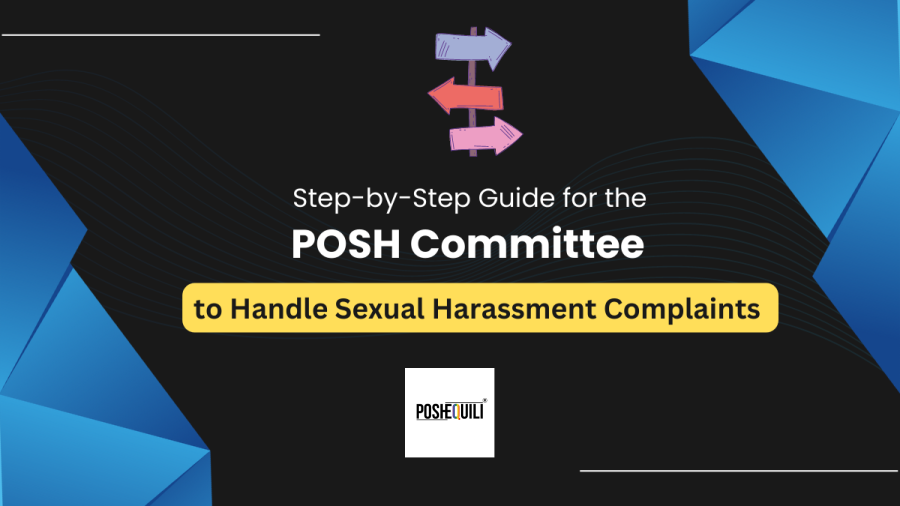A Step-by-Step Guide for the POSH Committee to Handle Sexual Harassment Complaints
Sexual harassment at the workplace is a concern across industries. It imposes a range of costs that impact individuals, including the aggrieved person, the respondent (i.e., the person against whom a complaint has been filed), the other employees and the company at large. In India, we have a dedicated law named the Sexual Harassment of Women at Workplace (Prevention, Prohibition and Redressal) Act (POSH Act) which was enforced in 2013. The objective of this act is to create safe workplaces for women in our country and protect their dignity.
The law has laid down detailed provisions with regards to the redressal mechanism. It mandates that every organization having 10 or more employees should create an Internal Committee (IC- formerly known as the Internal Complaints Committee) which will inquire into complaints of sexual harassment at the workplace. The POSH Act has also specified the qualifications required to be an IC member, their term, grounds for removal, etc. Further details with regards to the constitution and composition of the Internal Complaints Committee can be found here.
The IC, by law, can only look into complaints wherein the aggrieved person is a female. However, the scope of this Act has also expanded over time. Now a transwoman can also file a complaint of sexual harassment at workplace. This was the result of the recognition of transgender as the third gender through the Transgender Persons (Protection of Rights) Act, 2019. Although the POSH Act protects only women, there has been an increasing trend of organizations formulating gender neutral POSH policies which means that people of any gender could file a complaint of sexual harassment with their respective organization.
Here is a step-by-step guide which will help the Internal Complaints Committee ensure that they handle the POSH complaints in a systematic and timely manner-
Step 1: Jurisdiction Check:
Once an IC receives a written complaint, the first thing that it should do is to check for jurisdiction. Following points should be covered while ascertaining if the IC has the authority to deal with the complaint-
- Check if the identity of the complainant as well as the respondent is mentioned in the complaint.
- Check if the allegations fall within the definition of ‘sexual harassment’ as per the POSH Act.
- Check if the complaint was filed within a period of 3 months from the last date of the incident. IC has the discretionary power to give a further extension of 3 months.
- Check if the Respondent is an employee of your organization.
- Check if the alleged incident took place at the workplace. To understand what constitutes a workplace, click here.
Step 2: Introductory Call with the Complainant:
Once the IC has determined its jurisdiction, the next step is to have an introductory call with the complainant. The objective of this call is to understand the allegations better, to explain the procedure laid out under the law and the redressal options available.
Step 3: Introductory Call with the Respondent-
The next step is to have an introductory call with the respondent. The objective of this call is to apprise the respondent of the complaint, inform them about the procedure and their rights.
Step 4: Forward the complaint copy to the Respondent-
Once the IC speaks to the respondent, it should forward a copy of the complaint to them. The objective is to ensure that the IC acts in a fair and an unbiased manner and give the respondent an opportunity to present their side of the story. This has not only been mentioned in the POSH Act but has also been reiterated by the courts. Further, the IC should ensure that this is done within a period of 7 working days from the date of filing of complaint.
Once the respondent receives the complaint copy, they get a 10 working days period to file their written response.
Step 5: Follow up with the Complainant on her choice of redressal option-
The complainant has the right to either opt of conciliation or inquiry. Conciliation is a form of settlement which can be requested in writing only by the complainant and before the inquiry has been initiated. If the complainant opts for conciliation, the same needs to be conveyed to the respondent who then gets the right to accept, deny or negotiate the conciliation terms.
Step 6: Examination of Complainant, Respondent and Witnesses-
If the complainant opts for inquiry, then the next step is to individually meet both the parties and the witnesses, if any, to have a detailed conversation regarding the complaint and ask questions which will help the IC ascertain if the allegations can be substantiated or not. Questions should be open-ended; they cannot be leading or personal in nature.
Step 7: Cross Examination-
Once individual statements of the parties are recorded, the next step is to let the parties cross-question each other. At this stage, the complainant and respondent will come face to face and ask questions, including pointed questions. Here the IC’s role is to supervise the conversation and disallow any personal or derogatory questions. The parties can also cross-examine the witnesses of their choice.
In exceptional circumstances, written cross-examination can be allowed. Click here to know more.
Step 8: Calling-
This is the final and an optional stage wherein the IC can call any of the parties or witnesses if it requires any further clarification before concluding. Here, leading questions can be asked.
All the above-mentioned steps needs to completed within 90 days.
Step 9: Inquiry Report-
Now the IC needs to prepare an inquiry report with a set of recommendations if the allegations are substantiated or if it’s a false or malicious complaint. The report needs to be generated and forwarded to the employer within 10 days. Once this is done, the employer gets 60 days to execute the recommendations.
These are the broad steps which the Internal Complaints Committee or the IC needs to follow while dealing with a sexual harassment complaint.
You can read more about the IC’s challenges and the law’s stand on it here.




